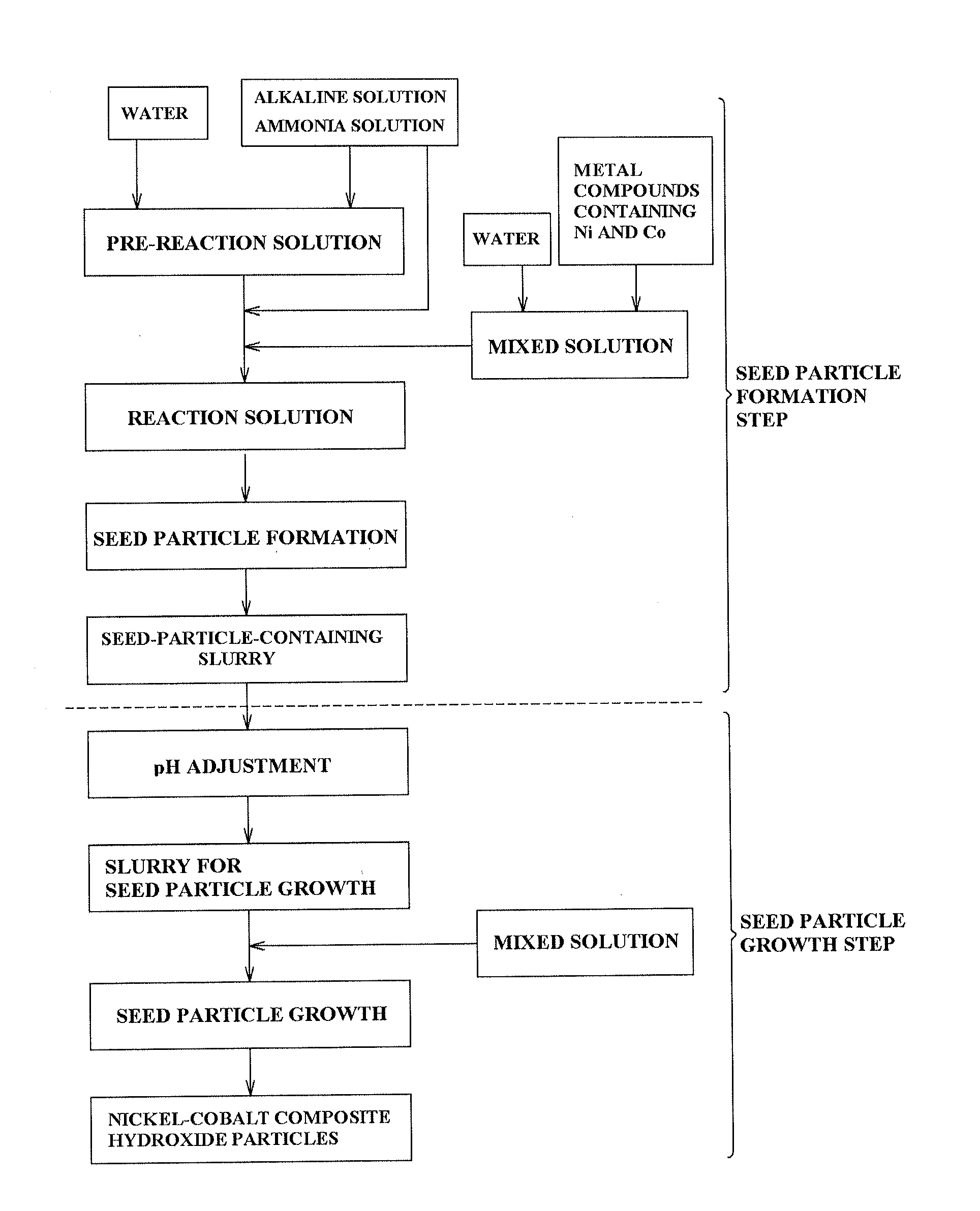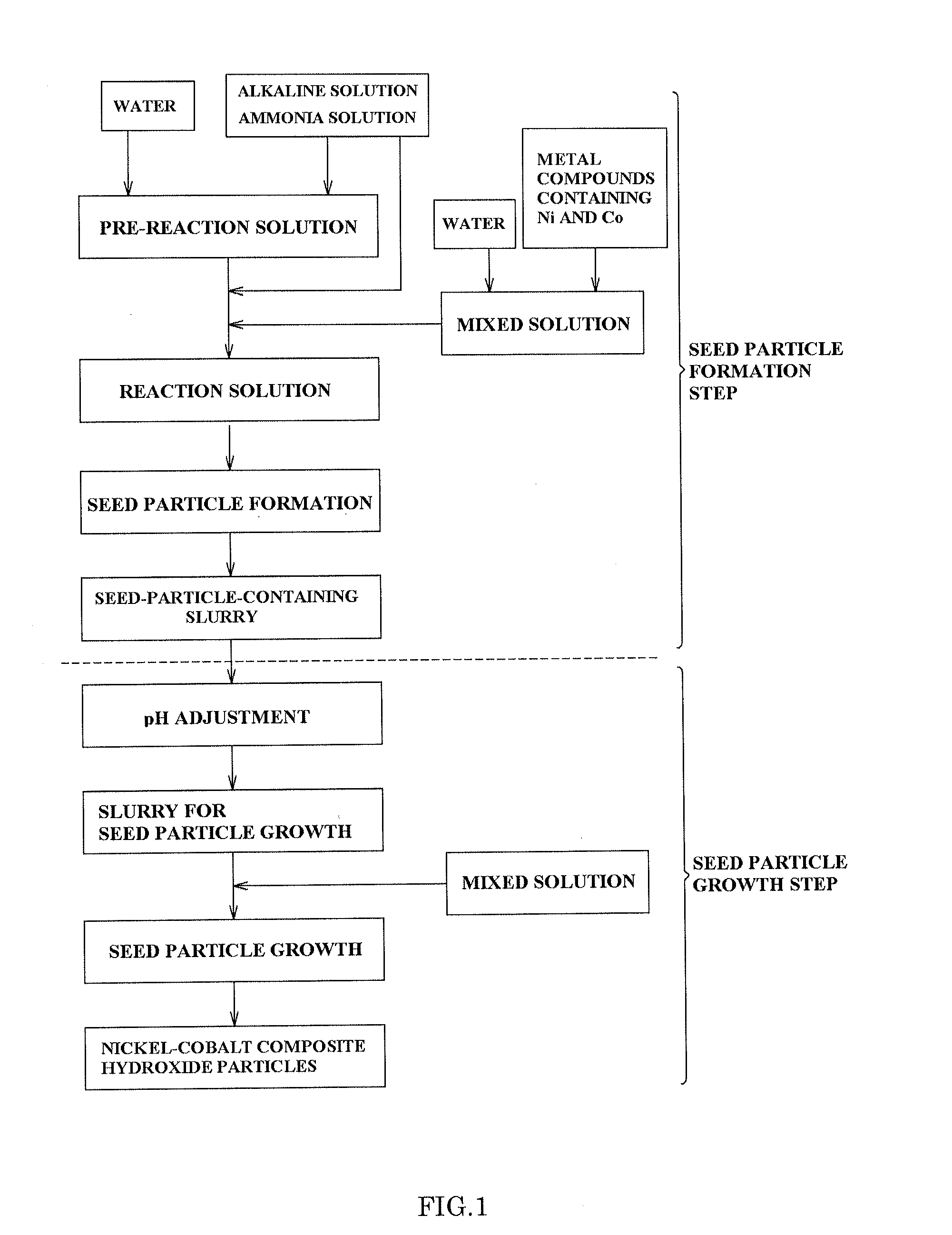Nickel-cobalt composite hydroxide and process for manufacturing same
a technology of composite hydroxide and nickel cobalt, which is applied in the direction of nickel compounds, sustainable manufacturing/processing, batteries, etc., can solve the problems of reducing the charge-and-discharge life, increasing the cost of positive electrode active materials, and difficulty in satisfying the yearly-increasing demands for a high-capacity lithium ion secondary battery. , to achieve the effect of high production efficiency, easy mass production, and excellent particle diameter
- Summary
- Abstract
- Description
- Claims
- Application Information
AI Technical Summary
Benefits of technology
Problems solved by technology
Method used
Image
Examples
example 1
[0160]In Example 1, 1.5 L of industrial water and 300 ml of 25 wt % ammonia water were fed into an overflow type crystallization reaction vessel I having a vessel volume of 2 L and having four baffle plates attached thereto, and heated to 50° C. by a thermostat and a heating jacket, and then a 24% caustic soda solution was added thereto, whereby the pH of a pre-reaction solution at 25° C. was controlled to be maintained in a range from 12.8 to 12.9. Actually, to precisely perform the pH control, the pre-reaction solution was taken and cooled to 25° C. and the pH thereof was measured, and the pH thereof at 50° C. was adjusted to 11.8 so as to achieve a pH at 25° C. of from 12.8 to 12.9, whereby the pre-reaction solution was obtained.
[0161]Using a three-bladed turbine impeller having a diameter of 3 cm, agitation was performed at 1500 rpm in the crystallization reaction vessel I. The discharge head calculated from the foregoing Equation 1 and Equation 2 was 50 m2 / s2.
[0162]A crystalliz...
examples 2 to 6
, Comparative Examples 1 to 6
[0167]In Examples 2 to 6 and Comparative Examples 1 to 6, a nickel-cobalt composite hydroxide was obtained and evaluated in the same manner as in Example 1, except that the respective nickel concentrations of the solutions in the crystallization reaction vessel I and the crystallization reaction vessel II were changed by adjusting pH and the concentration of ammonia, and the discharge head was changed by adjusting the number of revolutions of an agitator. Table 1 shows evaluation results.
TABLE 1Reaction vessel IReaction vessel IIParticle diameter of obtained nickel-cobaltNiNicomposite hydroxideconcentrationDischargeconcentrationDischarge(D50 − D10) / (D90 − D50) / in solutionheadin solutionheadD10D50D90D50D50ppmm2 / s2ppmm2 / s2μmμmμmμm / μmμm / μmExample 11-250250-300107.810.212.30.240.21Example 21-275250-300108.010.212.30.220.21Example 31-2100250-300108.110.011.90.190.19Example 43-575250-300108.811.314.00.220.24Example 51-275 5-10258.110.612.80.240.21Example 61-27...
PUM
 Login to View More
Login to View More Abstract
Description
Claims
Application Information
 Login to View More
Login to View More - R&D
- Intellectual Property
- Life Sciences
- Materials
- Tech Scout
- Unparalleled Data Quality
- Higher Quality Content
- 60% Fewer Hallucinations
Browse by: Latest US Patents, China's latest patents, Technical Efficacy Thesaurus, Application Domain, Technology Topic, Popular Technical Reports.
© 2025 PatSnap. All rights reserved.Legal|Privacy policy|Modern Slavery Act Transparency Statement|Sitemap|About US| Contact US: help@patsnap.com


